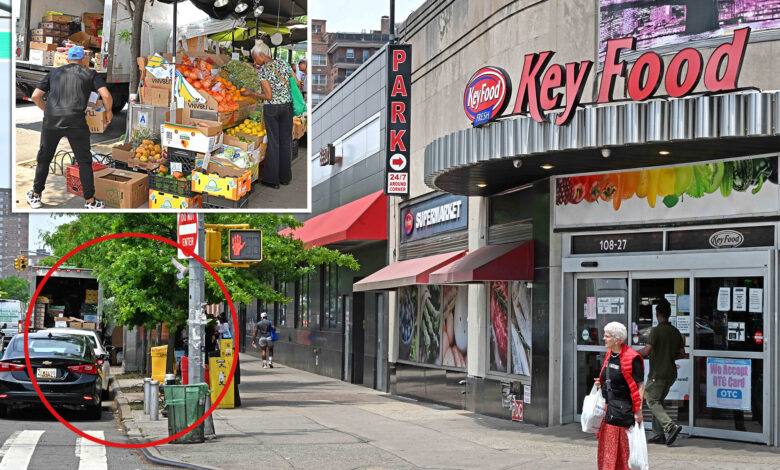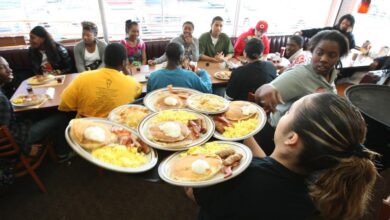NYC grocers gripe over fruit vendors so close to stores: ‘Pick off our customers’

City grocery-store owners are blasting Big Apple officials for allowing licensed fruit and vegetable vendors on the same block as their shops — in some cases fewer than 30 feet away — eating into their profits.
In Forest Hills, Queens, a fruit and vegetable stand is located just 25 feet from a Key Food supermarket on the northern side of Queens Boulevard between 71st Avenue and 71st Road.
“They know they can pick off our customers,” fumed Nelson Eusebio, political director of the National Supermarket Association, which reps 600 Key Food, C-Town, Associated, Bravo and other grocers in the city.
The window alongside the Key Foods has pictures promoting the sale of blueberries and asparagus — while the vendor sells the same fruit and veggies within eyeshot.
It’s just one one example of vendors and grocers operating almost cheek-to-jowl.
There are about 500 licensed fruit and vegetable vendors across the city aimed at providing fresh produce to neighborhoods that lack access, according to the city Health Department, which regulates them.
Fashionable Forest Hills is not a neighborhood with limited access to healthy fruit and vegetables, so to allow such streetside competition is unfair, grocers say — noting the overhead costs they have to pay such as for unionized labor, property and utility bills.
“This is a big burning issue,” Eusebio said. “We’re not against the vendors making a living. But don’t put them next to any store. It’s gotten out of hand.”
Gristedes owner John Catsimatidis said permitting food vendors to locate so close to his stores “destroys our produce department.”
He said it’s just another example of New York being anti-business.
“Business is down. Shoplifting is up,” Catsimatidis said. “A lot of drugstores have closed. Maybe the grocery stores will close.”
Catsimatidis joined Eusebio in lamenting that neither Mayor Eric Adams’ administration nor the City Council have addressed the gripes.
Forest Hills shoppers were divided on the grocers vs. vendor spat.
Paula, 75-year-old retiree who shops at both, sided with the vendors, saying she has a limited income and needs to watch her spending.
“Forest Hills is very, very expensive,” Paul said. “Key Food has everything, but prices are high. At the fruit stand, lemons are cheaper, broccoli is cheaper, tomatoes are cheaper, grapes are cheaper.”
“Don’t blame the vendor. They’re looking to survive,” she said. “These supermarkets make a lot of money. They’re selling a ton of products. They make money on everything.”
But Shawn, a Forest Hill office worker, said he doesn’t shop at fruit stands and agreed with grocers that putting vendors on the same block is unfair competition.
“They’re taking business from the supermarket. They should give a percentage of the business to the supermarket,” he said.
The fruit and veggie vendors pay a $200 annual permit to operate, plus $300 to $500 to store their carts — though some keep their tables on sidewalks 24-7.
“It’s definitely competition, but it’s not unfair competition,” said Matthew Shapiro, legal director of the Food Vendor Project of the Urban Justice Center, an advocacy group.
“It’s true that grocery stores have a lot of expenses, a lot of overhead. But they got a lot in return. Vendors get a fraction of the return. We got vendors, farmers’ markets, grocery stores. There’s something for everyone,” he said.
The city Health Department defended the food-vendor program and brushed off complaints of grocers regarding location.
“It’s important for communities to have a good mix of supermarkets, bodegas, farmers markets, green carts, etc. It’s easier to make healthy choices when healthy, affordable food is readily available,” a Health Department spokesman said.




